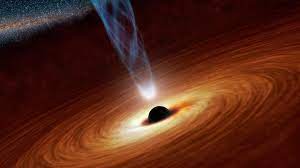The race to find sustainable energy has quite literally led us out of our world. Earth harvests energy from the Sun to keep itself alive, but for the ever-growing human species, even this massive star is not enough to satisfy our high energy needs. Ergo, scientists have been searching further into space for other sources to tap into, which brings us to a source right out of science fiction: black holes.
The first step in harvesting energy from a black hole lies in picking one. Contrary to common thought, larger black holes emit less energy, known as Hawking radiation. On the other hand, smaller black holes rapidly emit large amounts of Hawking radiation, though this causes them to rapidly destabilize and evaporate. Another consideration to factor in when picking a black hole is its spin. Rotating black holes, known as Kerr black holes, increases the conversion efficiency of mass to energy from 6% to 32%. As a reference, nuclear fission technology converts approximately 0.1% of mass to energy, demonstrating just how much energy can be extracted from a black hole.
“Rotating black holes, known as Kerr black holes, increases the conversion efficiency of mass to energy from 6% to 32%.”
The next step is to feed the black hole. Mass captured by the black hole does not directly get swallowed into the event horizon, but instead falls into orbit along the black hole’s accretion disk—a magnetic field surrounding the black hole —due to the conservation of angular momentum. As the object approaches the center of the black hole, it speeds up and interacts with other particles within the disk, radiating this energy out of the black hole.
Hawking radiation also causes black holes to emit energy – where mass converts to energy via an emission of black body radiation (heat and light) within the accretion disk. Two scientists from Columbia University and Universidad Adolfo Ibáñez also suggested using the magnetic field of spinning black holes to utilize its rotational energy. Their research proposed using magnetic reconnection, which allows parts of plasma in the ergosphere to accelerate and obtain infinitely high energy while the other part of the plasma accelerates against the black hole’s rotation and obtains negative energy. In this case, the accelerated plasma extracts rotational energy from the black hole while the latter plasma feeds into the event horizon.
Once energy leaves the black hole, it has to be transferred and collected for use on Earth. One suggestion for this challenge would be to build a Dyson ring, a modified Dyson sphere. Dyson spheres were suggested by physicist Freeman Dyson as a means to collect energy from a planet’s star. In the case of black holes, there would be a fleet of satellites surrounding it in a ring that would collect and direct the emitted energy back to Earth. This ring formation decreases the likelihood of damage from collisions with objects moving in space while also allowing masses to fall into the accretion disk for energy.
Unfortunately, tapping into black holes is a project for the world far into the future. Limitations in space travel, current material technology and availability, and the sheer cost of such a project prevent this idea from leaving theories on paper. It is an idea that would push the limits of humanity when realized, allowing us the capability to achieve more than allowed in modern society.






